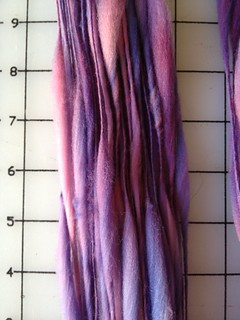For Weeks 11-12, we worked a bit more on Art Yarns, as well as working with luxury yarns, such as bison and cashmere.
It was a class where I really learned a lot and improved on my spinning skillset. It was a LOT of work (with a lot of homework that guaranteed that I was spinning every single night). Often times, there was plenty of spinning just singles so we could ply in class. or maybe some plying as homework for use in other projects. Despite all of the work, it was also a lot of fun. Our instructor, Sandy, was an excellent teacher. My classmates were clever and funny, and we supported each other through every assignment. (Plus, you got to see how other people did --- their frustrations and successes.)
I might take SpinU again in the future to refresh some of what I learned -- because I know I didn't grok some of what Sandy was explaining to us at that time. There was just SO much information that required processing.
If you have a LYS near you that offers something like SpinU, I highly suggest it. For the price, it was a great deal of learning and improving skillsets! (And for those of you in the SF Bay Area, Purlescence Yarns, offers this class (and a "beginners" SpinU) regularly.
Photo Summary of SpinU
Here is photo synposis of the yarns that I spun. Some of these yarns, I've already knitted into garments and am showing the previous photos (and I'm pretty sure I'm missing 1-3 skeins that I spun up for the class!)Plant Fibers:
From left to right:- Cotton Woolen - 2ply
- Cotton Worsted - 2ply
- Hemp, - 1ply
- Flax (wet spun) - single ply
- Bamboo Bast - 2-ply
Art Yarn Spun:
From left to right:- Beehives - black nylon yarn used as a base with tightly plied 2-ply silk to make the beehives.
- Encasement Art Yarn - nylon yarn with a motley of feathers, eyelash yarn, etc, used.
- Boucle - nylon base yarn with some generic wool singles
- Frosted Yarn - using a 2-ply silk yarn (I spun earlier) and some red fiber
When I brought home the "Encasement Art Yarn", DH thought it looked like Muppet Intestines. LOL . This yarn was a LOT of fun to create, but not something that I would use on a regular basis. But, creating this yarn is really the culmination of every technique that we learned in class.
More Art Yarn: Thick & Thins
Thick & Thin single using a slightly felted top -- I had overdyed some top and it came out every so slightly, which is perfect for this type of art yarn. (I gave this yarn away to one of my classmates.)(L2R)
- Thick & Thin Single - Using a batt
- Thick & Thin 2ply. Using some of the 1st skein, I made a second thick & thin out of contrasting yarn and plied them together.
I found that I actually enjoyed making thick & thin yarn from a batt versu the felted top. Sandy suggested maybe weaving with it, so that's what I'm going to do with this one.
Luxury Fibers:
I loved spinning these luxury fibers! I must spin more! Although, admittedly, I wasn't too happy spinning 100% silk. A few strands got into my eye and it was PAINFUL! (One of the hazards of spinning with silk.)From left to right:
- Cashmere/Silk - 52 yards - (1/2 oz) - 30% twist. 16-17 WPI. Ratio 12.5:1
- Bison (Woolen), 15 yards. -2ply 1/2 oz - Ratio 6.75:1
- Bison (Worsted) - 20 yards - 2 ply - Ratio: 13.75:1
- Not shown - 1 and 2-ply silk.
Spinning & Plying
One of the things we learned was how to spin the appropriate size of single for the resulting plied yarn that you wanted. So, if I wanted a 2-ply bulky (~6WPI), I knew exactly what size single I had to spin in order to achieve that bulky yarn. I'd never have to guess what type of singles I needed in order to make the yarn I wanted.The following skeins were all spun with BFL or Cormo
From Left to right:
- Woolen 4ply (2oz) - singles with 28-33WPI @ 20% twist,
- 120 yards 2 ply, singles - 40 WPI @ 30% twist
- Worsted 3 ply, > 30% twist angle
The following were spun with some of Purlescence's "Spin Up & Dye" fiber. What's nifty about using a dyed fiber is that you get to see how the color plays out in different weights & plies.
(L2R): 3Ply worsted; 2 ply bulky
There was also learning how to make stable singles that could be used for knitting and wouldn't fall apart on you.
(L2R)
- Brown Merino/Cormo cross - Woolen spun single, 28-32 WPI @ 20 % twist
- White: 2-ply lace yarn - 115 yards. I "think" this is superwash merino
Specialty Plying:
In addition to regular-old plying, we practiced for specific plying, such as plying with a very tight twist (for socks and such) to navajo to cable plying(L2R)
- Red: 3-2 cable ply -worsted -- akin to Greenland yarn
- Brown: Very tight twist 3 ply .
I hope you guys liked the photo summary of SpinU. Again, I highly recommend taking a class such as this to improve your skillset!










No comments:
Post a Comment